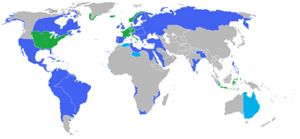The Napoleonic Wars were a global conflict during the late eighteenth and early nineteenth centuries. The primary adversaries were Britain and France.

Participants in the Napoleonic Wars. Blue: The Coalition and their colonies and allies. Green: The First French Empire, its protectorates and colonies, and allies. (Source: Wikipedia)
Main Combatants[]
Several nations fought on both sides of the Napoleonic Wars. However, the main nations involved in the fighting were: Britain, Austria, Russia, Prussia, along with their smaller allies and colonies, as members of the various coalitions formed to combat Napoleonic France. On the opposing side was France, and its smaller allies and colonies. The Wars are also notable because of the number of nations that switched sides during the war. The most famous of these is Spain, but Prussia, Austria, Netherlands and others of the German States also changed allegiance at some point during the conflict.
Within Show the Colours[]
Within Show the Colours, we focus on two main theatres of war: the Peninsular War in Spain, and the Royal Navy, represented by a 32-gun frigate, HMS Terpsichore. Our focus is mainly on the British experience as that enables us to keep a tight focus and have far more character interactions than would occur with characters spread out across the conflict as a whole.
Outcome and Lasting Effects[]
After losing the Battle of Waterloo in 1815, Napoleon was sent into exile by the allies. The Napoleonic Wars also served to weaken existing colonial empires like Spain, and strengthen growing powers like Britain. It caused the break-up of the Holy Roman Empire, as well as allowing Prussia to become the dominant Germanic nation, and gave it the chance to unit the Germanic states into one, later in the 19th century.
